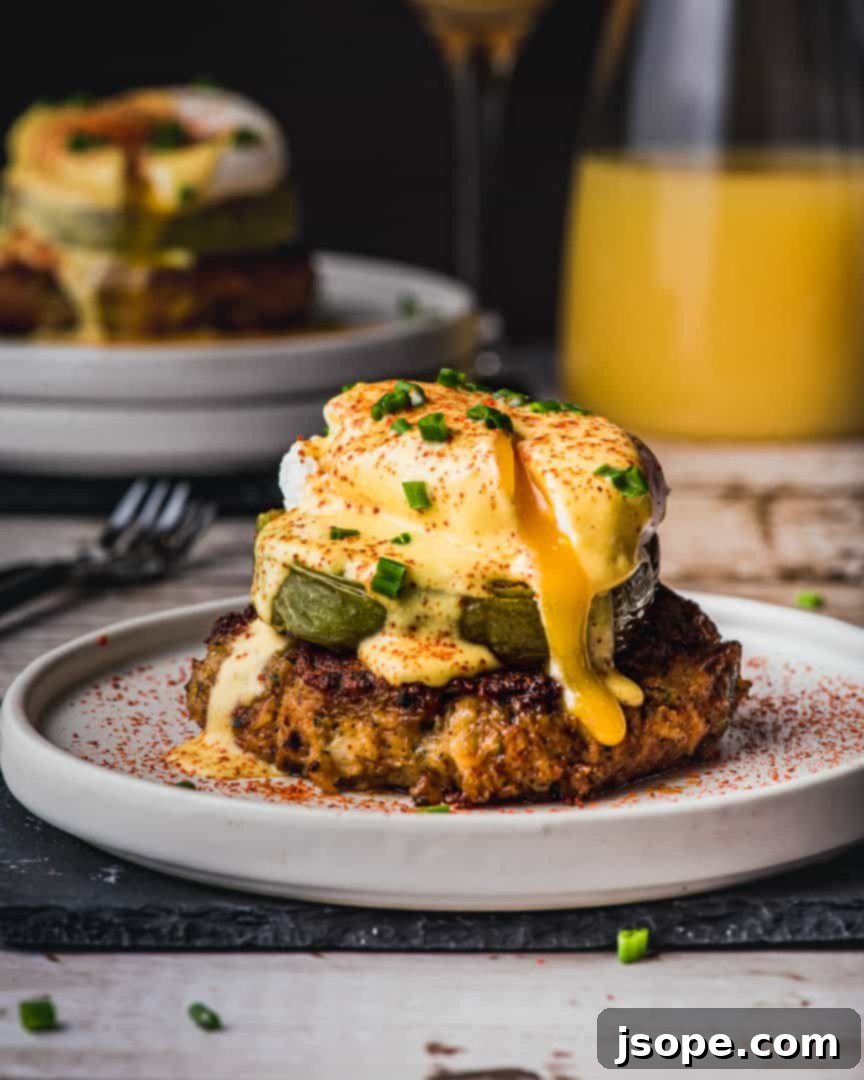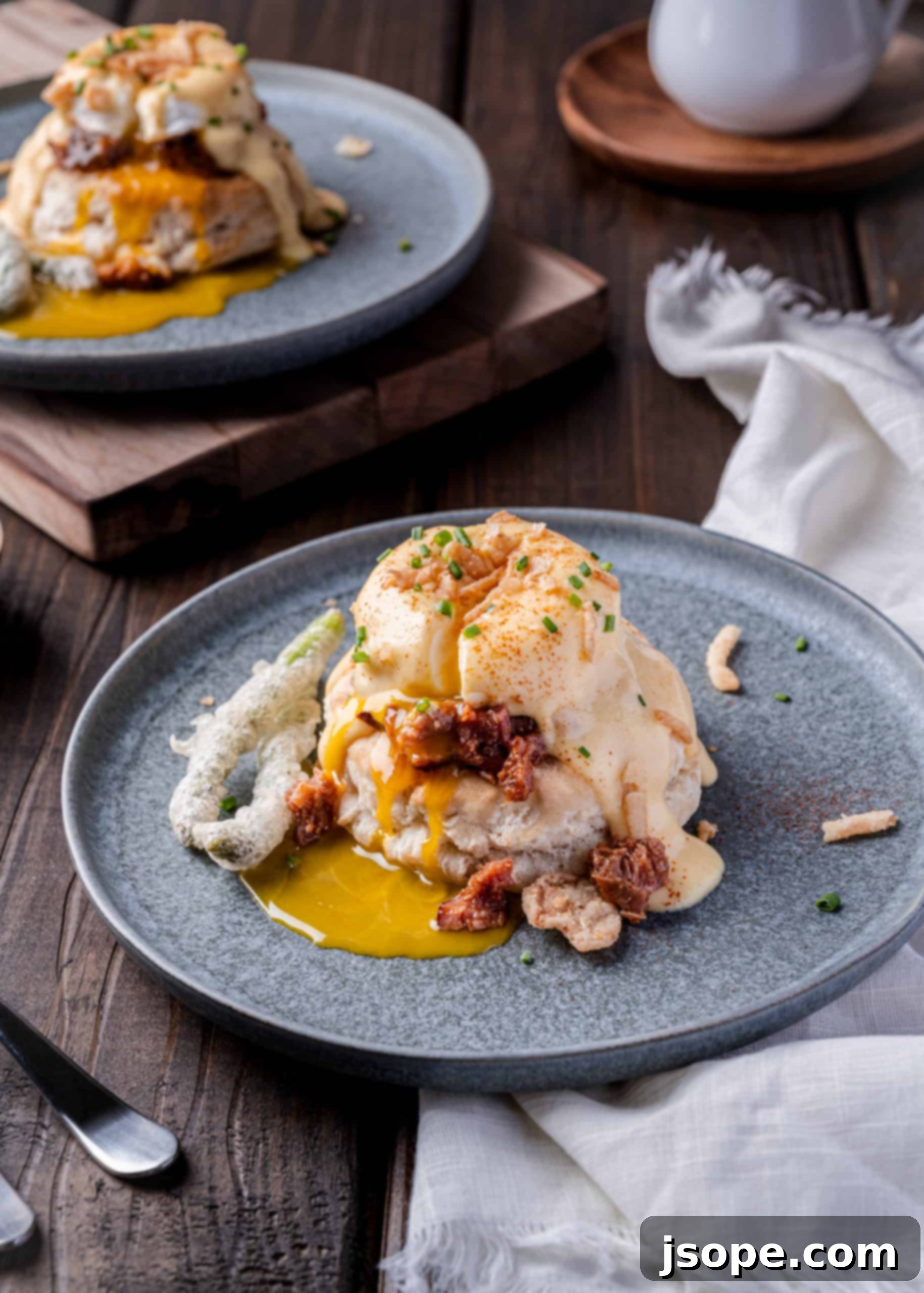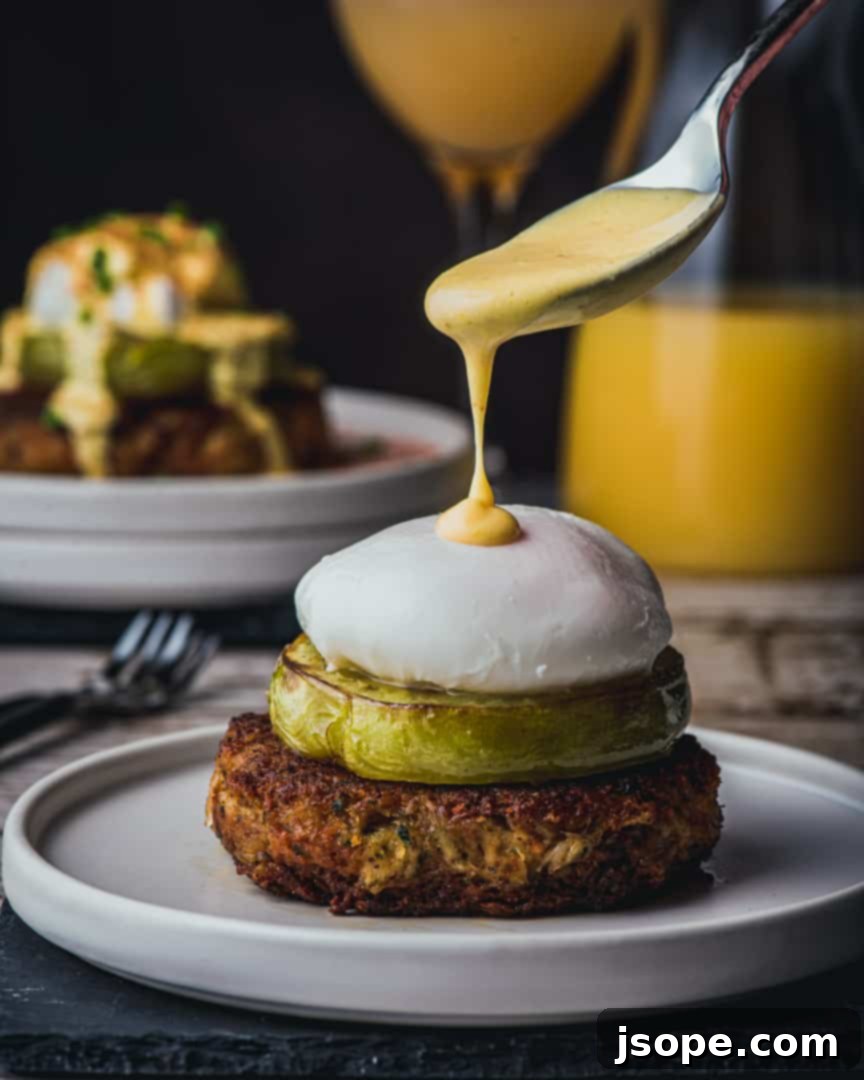Eggs – a culinary cornerstone and undoubtedly one of our favorite foods. Their unparalleled versatility makes them indispensable in countless dishes, from simple breakfast scrambles to intricate baking, rich sauces, decadent desserts like gelato, and so much more. The “incredible edible egg” truly lives up to its long-standing reputation. Among the myriad ways to enjoy them, Eggs Benedict stands out as a luxurious, iconic dish that graces brunch tables worldwide. While its reputation suggests complexity, mastering Eggs Benedict is entirely achievable with the right techniques. This comprehensive guide will equip you with our best tips and tricks, ensuring you can create a flawless, restaurant-quality Eggs Benedict every single time.

Crafting the Perfect Classic Eggs Benedict
Eggs Benedict is arguably one of the most beloved and elegant breakfast or brunch dishes. Its timeless appeal lies in the harmonious blend of textures and flavors: a perfectly poached egg, nestled atop a savory slice of seared Canadian bacon, all resting on a toasted English muffin, and generously draped with a rich, tangy hollandaise sauce. While many variations exist, we often find ourselves returning to the original. There’s a certain magic to the classic rendition that simply can’t be replicated. A light sprinkle of paprika or cayenne for a touch of warmth and vibrancy, along with fresh chives or green onions for a pop of color and herbaceous note, completes this masterpiece, transforming a simple meal into an extraordinary culinary experience.
The Intriguing Origins of Eggs Benedict: A Culinary Journey
Have you ever wondered about the true origins of Eggs Benedict? It’s a dish with an intriguing backstory, often sparking debates among culinary historians. Is it truly an American creation, considering it features Canadian-style protein, English bread, and a classic French sauce? The prevailing narrative, widely accepted across culinary circles, points to its birth in late 19th-century New York City. While precise details vary, two prominent theories emerge: one credits a Wall Street broker named Lemuel Benedict, who, in 1894, supposedly ordered a hangover cure at the Waldorf Hotel consisting of buttered toast, poached eggs, crisp bacon, and hollandaise. Another theory attributes it to Delmonico’s Restaurant, where it’s said to have been invented by their chef, Charles Ranhofer, for a Mrs. LeGrand Benedict. Regardless of the exact patron or chef, the consensus firmly places its invention in the vibrant culinary landscape of the United States.
Let’s delve deeper into the individual components. The exquisite hollandaise sauce, often considered the soul of Eggs Benedict, is indeed a pillar of French cuisine. It proudly stands as one of the five “mother sauces,” alongside béchamel, velouté, espagnole, and tomato sauce. Its rich, buttery, and tangy profile is undeniably what most people associate with Eggs Benedict, and for excellent reason – it’s a match made in culinary heaven! Beyond its star role in a Benny, hollandaise also beautifully complements other dishes, such as tender asparagus or a perfectly seared steak. Traditionally, the sauce calls for clarified butter. This practice historically helped nullify the variability in butterfat content that differed greatly between regions and brands. However, for the home cook using high-quality, high-butterfat “European-style” butter, using whole butter often yields equally excellent results, adding a deeper, nuttier flavor. The restaurant industry often prefers clarified butter for its stability and ease of use in a fast-paced environment, as it simplifies the emulsification process and keeps the sauce more consistent over time.
And what about the English muffin? As its name suggests, these delightful, nooks-and-crannies filled breads are, in fact, English in origin. In England, they are simply referred to as muffins, with the “English” prefix added elsewhere to differentiate them from other muffin varieties. Their ability to crisp up beautifully while retaining a soft interior makes them the ideal foundation for the layers of flavor in Eggs Benedict, securing their place as a truly outstanding culinary contribution from across the pond.
Now, for the “Canadian bacon.” Is it truly Canadian? This is where the story gets a bit more complex. What Americans commonly call Canadian bacon is not universally known by that name in Canada. In Canada, it’s typically referred to as “back bacon,” and it’s derived from the lean loin of the pig, rather than the fatty belly used for traditional streaky bacon. So, the supermarket variety you find in the U.S. is neither truly “Canadian” in name in its country of origin, nor is it “bacon” in the traditional sense of cured pork belly. Many Canadians might indeed look confused if you ask them for “Canadian bacon.” However, in the grand scheme of delicious food, the name matters less than the taste. Whether you call it Canadian bacon, back bacon, or simply a delicious slice of lean pork, its mild, savory flavor provides a perfect counterpoint to the richness of the egg and hollandaise.

So, there you have it – a delightful dive into the history and etymology of this brilliant dish’s components. Understanding the roots of our food often adds another layer of appreciation to every bite.
Demystifying Eggs Benedict: It’s Easier Than You Think!
Why does such a magnificent dish — equally perfect for breakfast, brunch, lunch, or even a light dinner — intimidate so many home cooks? The answer typically boils down to two key components: achieving perfectly poached eggs and mastering the delicate art of hollandaise sauce. While these aspects require a touch of finesse and practice, they are far from impossible. With a little guidance and patience, you’ll soon find these techniques become second nature. In our experience, the most challenging part isn’t the individual steps, but rather the orchestration of getting everything plated hot and fresh. Timing is crucial, and a well-planned approach makes all the difference. Here’s a simplified breakdown of how we manage the assembly to ensure every element is at its peak when served:
- **Preparation of Base Components:** We begin by preparing the elements that can hold their warmth. This involves searing the Canadian bacon to a beautiful golden crisp and toasting the English muffin halves until they are lightly browned and fragrant. Once ready, these components are gently wrapped in foil and kept warm in a low-temperature oven, around 170°F (77°C), while we focus on the more time-sensitive items.
- **Crafting the Hollandaise Sauce:** Next, we tackle the hollandaise. This exquisite sauce is made and then carefully kept warm over a double boiler. The goal here is merely to maintain its temperature and silky consistency, not to continue cooking it, which could lead to curdling. Proper temperature management is key to preventing the sauce from breaking.
- **Perfecting the Poached Eggs and Assembly:** With the base and sauce warm and ready, our full attention turns to poaching the eggs. This allows us to focus entirely on achieving that ideal runny yolk and firm white. As each egg finishes cooking, it’s immediately placed onto the pre-assembled English muffin and Canadian bacon, followed by a generous pour of warm hollandaise. This streamlined process ensures that every component is served at its optimal temperature and freshness.
Don’t be disheartened if your first attempt isn’t flawless. Culinary mastery, especially with dishes like Eggs Benedict, comes with practice. The most important thing is to try, learn from each experience, and refine your technique. You might even surprise yourself and achieve perfection on your very first try – just be sure to remember what you did!
The Art of Poaching Eggs: Achieving Velvety Perfection
For many, the idea of poaching an egg conjures images of delicate, wispy whites and frustrating failures. It’s often perceived as the most intimidating step in making Eggs Benedict. However, with a clear, straightforward method, it becomes a much more approachable task. We’re going to break it down to the absolute essentials, focusing on delivering that classic poached egg: a beautifully set, firm white encasing a wonderfully runny, golden yolk. If your preference is for a hard yolk, a hard-boiled egg might be a more suitable choice, as this technique is specifically designed for that delightful liquid center.

The vessel you choose for poaching can make a difference. We highly recommend using a Le Creuset Dutch oven or any similar enameled cast iron pot. These pots excel at retaining and distributing heat evenly, which is crucial for maintaining a consistent water temperature – a key factor in successful poaching. While any pot will work, the superior heat retention of cast iron makes it easier to keep the water at that perfect, gentle simmer, leading to more consistent results. This allows for a more relaxed poaching process, as you won’t be constantly adjusting the heat.
Our Tried-and-True Method for Perfectly Poached Eggs
Follow these steps for consistently beautiful poached eggs:
- Prepare Your Poaching Water: Start by filling a medium to large pot with about 4-6 inches (10-15 cm) of water. Bring this water to a full, rolling boil over high heat. Once boiling, immediately reduce the heat to a gentle, aggressive simmer. The water should have small, consistent bubbles rising, but it should not be vigorously boiling. A violent boil can break apart the delicate egg whites.
- Add a Touch of Vinegar: To the simmering water, add about a tablespoon of distilled white vinegar or rice vinegar. The acidity from the vinegar helps the egg whites coagulate more quickly and hold their shape, preventing them from spreading out into wispy strands in the water. Don’t worry, you won’t taste the vinegar in the final product.
- Crack Eggs Individually: This step is critical for success. Gently crack each egg into its own individual ramekin or a small bowl. This allows you to inspect the egg for any shell fragments and, more importantly, ensures the yolk is intact. If a yolk breaks at this stage, it’s best to discard that egg and try again, as a broken yolk will not poach correctly. If you find a tiny piece of shell, a plastic spoon or a wet finger is perfect for retrieving it without damaging the egg. Some chefs advocate for straining the egg through a fine-mesh sieve to remove the very loose outer whites, which can create wisps. While this can yield a slightly tidier egg, we’ve found it doesn’t make a dramatic difference for home cooking.
- Gentle Immersion and Whirlpool Technique: Using a spoon, create a gentle whirlpool in the simmering water. Carefully and gently slide one egg from its ramekin into the very center of the whirlpool. Immediately after, give the egg a gentle nudge off the bottom of the pot with a rubber spatula to prevent it from sticking. This also helps it catch the current of the whirlpool. If you’re poaching multiple eggs, quickly repeat this process, adding subsequent eggs into newly created whirlpools or near the outer edge of the pot. Work efficiently to ensure all eggs cook similarly. If you notice excessive wispy egg white strands, it often indicates the water is too hot; reduce the heat slightly.
- Monitor Cooking Time and Visual Cues: The ideal cooking time for a perfectly runny yolk with firm whites is approximately 2 minutes. However, this is a guideline, not an absolute rule. Variables like water temperature, the size and freshness of your eggs, and even the type of pot can influence cooking time. The most reliable method is to use your senses. Keep a close eye on the whites; when they appear set and firm, gently remove one egg with a slotted spoon. Tilt it from side to side to assess the firmness of the white. It should be firm to the touch but still have a slight wobble. If it looks good and the yolk feels slightly yielding, your eggs are ready! This skill takes a little practice, so don’t be discouraged if your first few aren’t perfect.
The Grand Finale: Assembling Your Eggs Benedict
The two minutes your eggs are poaching are your “go time” for assembly! This is where planning and efficiency come into play. While the eggs are in the water, quickly retrieve your toasted English muffins and seared Canadian bacon from the warm oven and arrange them on your serving plates. By the time your eggs are ready, your base should be waiting. As you remove each perfectly poached egg from the simmering water with a slotted spoon, gently transfer it to a paper towel in your other hand. This critical step absorbs any excess water, preventing a soggy Benedict. Then, carefully place the dried poached egg onto your assembled muffin and bacon. Finally, give your warm hollandaise sauce a final, vigorous stir to ensure its velvety consistency is perfect, and generously spoon or pour it over the eggs. Garnish with a sprinkle of paprika and fresh chives, and serve immediately to enjoy its exquisite warmth and flavor.
The Crown Jewel: Eggs Benedict Sauce (Hollandaise)
The hollandaise sauce is, without a doubt, the defining element of Eggs Benedict. Its rich, creamy texture and vibrant flavor elevate the entire dish. While there are many variations, we lean towards a hollandaise that offers a bright, citrusy tang with a subtle kick of spice, rather than an overly eggy profile. Our preferred version, a zesty Lemon Hollandaise Sauce, perfectly balances the richness of the butter with refreshing acidity and a hint of cayenne, and you’ll find its full instructions in the recipe section below.

The amount of sauce is a matter of personal preference. If you’re a true hollandaise enthusiast, feel free to lavishly pour it on! However, we find that a more moderate, balanced amount allows the other components of the Benedict to shine through equally. Crafting hollandaise can seem daunting due to its reputation for breaking or curdling. While we provide detailed instructions in the recipe, a few quick tips can significantly improve your success rate. The most common issues arise from overheating or insufficient emulsification. If your sauce shows signs of breaking (separating into oily and watery layers), an immersion blender can often be your best friend, quickly bringing it back to a smooth, cohesive emulsion. Consistent whisking and careful temperature control are your allies in preventing these issues from occurring in the first place.
Essential Tips & Tricks for a Flawless Eggs Benedict
For those who appreciate concise advice, here’s a compilation of quick tips to help you master Eggs Benedict and achieve perfection every time:
- **Hollandaise Sauce Safety & Consistency:** For food safety, hollandaise sauce should always be kept above 140°F (60°C) and served within two hours of preparation. Making it far in advance is not recommended.
- **Fixing Thin or Broken Hollandaise:** If your hollandaise sauce turns out too thin or begins to separate, an immersion blender is a fantastic tool to quickly re-emulsify and thicken it to the desired consistency. A few quick pulses usually do the trick.
- **Adjusting Hollandaise Thickness:** Hollandaise tends to thicken as it stands, even over a double boiler. Taste it before serving. If it becomes too thick for your liking, you can thin it out with a small amount of warm water or an extra squeeze of lemon juice. This is purely a matter of personal preference; some prefer a very thick sauce, while others like it slightly thinner.
- **The Freshest Eggs are Key for Poaching:** Always use the freshest eggs you can find for poaching. Farm-fresh eggs, ideally from a local farmers’ market, have tighter whites that hold their shape much better in the water, resulting in a neater, more compact poached egg.
- **Optimal Poaching Vessel:** An enameled cast iron pot, such as a Le Creuset Dutch oven, is ideal for poaching eggs. Its superior heat retention ensures a stable water temperature, leading to more even and consistent cooking of the eggs.
- **Crack Eggs into Ramekins:** Always crack each egg into an individual ramekin or small bowl before introducing it to the poaching water. This allows you to check for a perfectly intact yolk and easily remove any shell fragments. It also makes for a smoother, more controlled transfer into the water, helping the egg maintain its compact shape.
- **Flavoring Your Hollandaise:** Don’t hesitate to experiment with the acidic component in your hollandaise. While lemon juice is classic, a splash of white vinegar or even a different citrus juice can offer a unique twist. Adjust to your taste preferences.
- **Practice Makes Perfect for Poaching:** The precise cooking time for poached eggs can vary. Use 2 minutes as a general guideline for a runny yolk and firm white, but rely on visual cues and gentle touch. Practice is the best way to develop an intuitive feel for when your eggs are perfectly cooked.
- **Drying Poached Eggs:** Before plating, always gently place your poached eggs on a paper towel to absorb excess water. This prevents diluting the hollandaise and keeps your English muffin from getting soggy.
Creative Twists: Modifications on the Classic Eggs Benedict
While the classic Eggs Benedict is a masterpiece, culinary exploration is always encouraged! The beauty of this dish is how easily it lends itself to creative modifications, allowing you to personalize it to your taste or occasion. Here are just a few delightful variations we’ve enjoyed, offering both subtle changes and complete transformations:
- **Protein Swap:** Instead of Canadian bacon, try substituting seared summer sausage, prosciutto, smoked salmon (for an “Eggs Royale”), or even grilled portobello mushrooms for a vegetarian option.
- **Garnish Variety:** While chives are traditional, feel free to experiment with other fresh herbs for garnish. Fresh parsley, cilantro, dill, or a sprig of thyme can each add a different aromatic dimension.
- **Southern Comfort Benny:** For a decadent Southern-inspired twist, replace the English muffin with a crispy crab cake and swap the Canadian bacon for a slice of fried green tomato. The combination of seafood, tangy tomato, and rich hollandaise is sublime.
- **Citrus Infusion:** Play with the citrus in your hollandaise sauce. Fresh orange juice can create a slightly sweeter, brighter sauce, while grapefruit juice offers an intriguing, more bitter tang. Any citrus, carefully balanced, can work wonders!
- **Bread Alternatives:** Explore different bread bases. A good quality Italian or French bread, or a rich, buttery brioche, can offer a delightful textural contrast to the classic English muffin. Consider even cornbread for a unique flavor profile.
- **Cheesy Addition:** Introduce cheese in any form to the assembly. A slice of provolone melted onto the Canadian bacon, a sprinkle of grated Parmesan, or a creamy dollop of goat cheese can add an extra layer of savory richness to your Benedict.
We wholeheartedly encourage you to try these modifications or invent your own. The possibilities are endless, and the joy of cooking lies in discovery. Let us know what delicious combinations you come up with! Happy egg-ing!
Enjoy Your Culinary Creation!
We sincerely hope you find immense pleasure in preparing and savoring this recipe for a classic Eggs Benedict. There’s truly nothing quite like a homemade Benny, and we believe our tips will guide you to culinary success. If you give this recipe a try, please don’t hesitate to leave us a comment below and share your experience, or tag us on Instagram @cooking_with_wine! We love seeing your delicious creations!
Looking for more delightful breakfast and brunch recipes? Explore these other favorites from our kitchen:
- Eggs in Purgatory – Italian Baked Eggs in Garlic Tomato Sausage Sauce
- Biscoff Cinnamon Waffles with Nutella Cream
- Crunchy Brioche French Toast with Orange Curd, Chocolate Sauce and Mascarpone Whipped Cream
- Coffee Cake Muffins with Vanilla Cardamom Glaze
📖 Recipe: Classic Eggs Benedict

Classic Eggs Benedict
Making Eggs Benedict seems daunting but could not be easier! This decadent recipe with a lemon hollandaise sauce will be your new favorite weekend brunch recipe!
Prep Time: 10 mins
Cook Time: 15 mins
Total Time: 25 mins
Course: Breakfast, Brunch
Cuisine: American
Servings: 4 servings
Calories: 380 kcal
Ingredients
For the Eggs Benedict:
- 4 Large fresh eggs
- 2 English muffins, split
- 4 slices Canadian bacon
- 1 TBS white vinegar
Garnish:
- Paprika
- Chopped chives
Lemon Hollandaise Sauce:
- 3 Egg yolks
- 2 tablespoon Water
- 1 pinch kosher salt
- 6 tablespoon butter (room temp/softened)
- 2 tablespoon fresh lemon juice
- ½ teaspoon cayenne pepper
Instructions
- **Preparation:** Preheat an oven to 170°F (77°C) or set it to a warming function. Bring a medium-large wide pot of water to a boil.
- **Toast Muffins & Sear Bacon:** While the water heats, toast the English muffin halves until golden. In a dry pan over medium heat, sear the Canadian bacon slices until lightly browned to your preference on both sides. Once done, loosely wrap the muffins and bacon separately in foil and place them in the warm oven to keep hot.
- **Make Your Hollandaise Sauce:**
- In a saucepan, combine egg yolks, water, and salt. Place over very low heat. Whisk constantly and vigorously. The sauce should gradually thicken, typically within 5 minutes. Be careful not to scramble the yolks with too high heat.
- Once thickened, gradually whisk in the softened butter, one tablespoon at a time, until fully incorporated and smooth.
- Stir in the fresh lemon juice and cayenne pepper.
- The sauce should be a lovely pale yellow color and have a thick, creamy consistency. Keep it warm over a double boiler (a bowl set over a pot of simmering water, ensuring the bowl does not touch the water) until ready to serve. Alternatively, an insulated bottle can keep it warm. Ensure the sauce’s temperature remains above 140°F (60°C) for food safety.
- **Poach Your Eggs:**
- Reduce the heat on your large pot of boiling water until it is at a gentle simmer. Add the white vinegar to the water. Carefully crack each egg into its own individual ramekin.
- When the water is simmering gently, use a spoon to create a soft whirlpool in the center. Carefully slide one egg from its ramekin into the middle of the whirlpool. Gently loosen the egg from the bottom with a rubber spatula and move it slightly towards the outside of the pot. Quickly repeat this process for the remaining 3 eggs. While the eggs are poaching, ensure your English muffin and Canadian bacon are assembled on plates, ready.
- Cook the eggs for approximately 2 minutes for a runny yolk and firm white. Use this as a guideline, adjusting based on visual cues. Once cooked to your liking, remove the eggs from the water with a slotted spoon, gently dab them with paper towels to remove excess water, and carefully place them onto the prepared muffin and Canadian bacon.
- Give the warmed hollandaise sauce a final whisk. Generously pour the sauce over each poached egg. If the sauce has become too thick, you can thin it with a tiny amount of warm water, whisking well. Finish with a sprinkle of paprika (and additional cayenne if desired for more heat) and chopped chives. Serve immediately and enjoy!
Nutrition
Here’s a general nutritional breakdown per serving of this Classic Eggs Benedict recipe:
- **Calories:** 380 kcal
- **Carbohydrates:** 15g
- **Protein:** 17g
- **Fat:** 28g
- **Saturated Fat:** 14g
- **Polyunsaturated Fat:** 3g
- **Monounsaturated Fat:** 9g
- **Trans Fat:** 1g
- **Cholesterol:** 391mg
- **Sodium:** 613mg
- **Potassium:** 236mg
- **Fiber:** 1g
- **Sugar:** 0.5g
- **Vitamin A:** 1084 IU
- **Vitamin C:** 3mg
- **Calcium:** 69mg
- **Iron:** 2mg
Keyword: Cooking tips, Eggs, Eggs Benedict Recipe, Poached Eggs, Hollandaise Sauce, Brunch Ideas
Let us know how it was!
